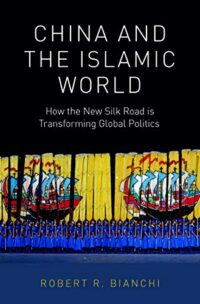
Review of China and the Islamic World by Robert Bianchi. Oxford, 2019.
As China builds out its globe-spanning network of infrastructure, another commonality binds together the Southeast and Central Asian, Middle East and African nations in which it is operating: China’s key partner in each region is predominantly Muslim. This is the framing with which Robert Bianchi, a political scientist and lawyer, approaches his book on China’s Belt and Road Initiative.
Centered on profiles of six nations – Pakistan, Turkey, Indonesia, Iran, Nigeria, and Egypt – Bianchi details the complicated political situations (often with sectarian or ethnic dimensions) China is simultaneously entering. Contrary to the narrative of a Chinese hegemon corrupting local societies, Bianchi finds that civil societies have often been successful in spurring their leaders and China to make substantive changes. Moreover, he underscores that the leaders of these nations have regional ambitions of their own, with plans “to influence China at least as much as China influences them.”
While Bianchi has identified the crucial nodes in China’s global expansion, he makes an unconvincing case for Islam as an organizing framework for understanding them. While China’s diplomats may “portray China and Islam as the twin centers” of the world temporarily displaced by the West and destined to be restored to global power, Bianchi does not demonstrate that Islam is an important consideration in China’s foreign policy with any of the nations profiled individually or collectively. Similarly, he gives little insight into the extent to which each country weighs Islam as a factor in its foreign policy; the most important pan-national Islamic organization, the Organization of Islamic Cooperation, goes entirely unmentioned. Although popular protest frequently follows China’s investments, Bianchi also makes little effort to understand (the generally quite favorable) popular opinion about China outside of specific incidents.
Apart from Turkey, Muslim countries have been conspicuously silent about China’s repression of its Muslim Uighur population. Experts estimate more than one million Uighurs have been imprisoned and those who are nominally free are subject to a troublingly pervasive police-state. Bianchi’s discussion of Xinjiang is consequently limited and only briefly contrasted with the experience of China’s ethnically Chinese, Mandarin-speaking Hui Muslim minority. Bianchi’s claim that “the continuous development of Islam inside China changes the way Chinese people define themselves as a nation and as members of the human family” seems disconnected from a country that is increasingly Han-centric and openly calls for the “Sinicization” of religions.
With any comparative book, some unevenness across chapters is expected. Frequently, the country chapters get too far into the weeds of local politics. Throughout, Bianchi’s forthrightness alternates between incisive one-liners about the countries he profiles and unnecessary editorializing, especially about his pessimistic take on China’s domestic politics. The concluding chapter’s summary of China’s leading scholars on Islam world, while interesting, feels underdeveloped and bolted on.
Country-specific insights do emerge, even if they cannot be aggregated to a pan-Islamic perspective. In Pakistan, the country’s limited influence beyond Afghanistan and intense focus on India is “precisely where China would like it to remain.” By contrast, an ambitious Turkey seeks to leverage China’s investments to further its own vision as a Eurasian bridge. Egypt is diminishing in importance amid alternatives to the Suez Canal, while Iran “has created too many enemies” among the partners Beijing wants to cultivate. In Nigeria, “having the deepest pockets and the most fragile reputation, China’s government is the target of choice for politicians, journalists, and citizens determined to correct what they see as corruption and injustice.” Indonesia’s troubled history with its ethnic Chinese minority and maritime disputes play a bigger role in its relationship with China than Islam and the Belt and Road.
China and the Islamic World ultimately fails to demonstrate that religion is an illuminating lens to understand China’s growing presence on the international stage. (Potential readers would be better served by recent journalism exploring China’s history in Xinjiang, the police state it has constructed there, how China is buying the silence of Muslim countries, and how the country is attempting to “Sinicize” religions.) But Bianchi does convincingly reinforce that China is entering regions it does not fully understand, is unwilling to exercise the leadership its influence demands, and is surprisingly vulnerable to being manipulated itself.